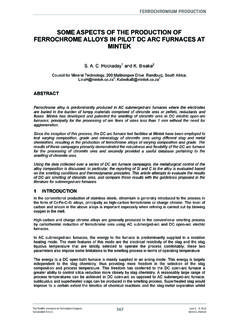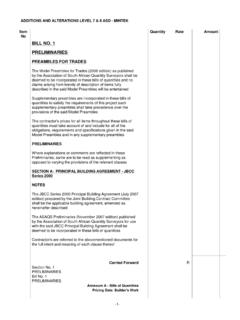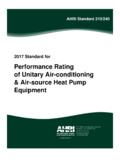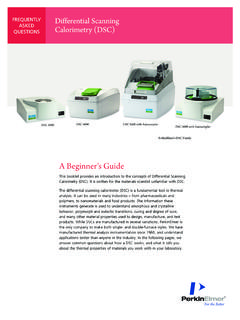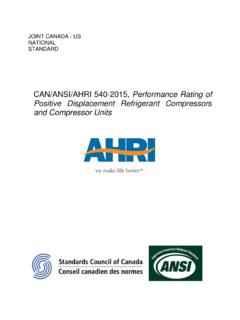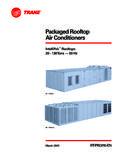Transcription of R.T. Jones - MINTEK
1 Thermodynamics and its applications an overview by Jones E-mail: Abstract: The laws of thermodynamics provide an elegant mathematical expression of some empirically-discovered facts of nature. The principle of energy conservation allows the energy requirements for processes to be calculated. The principle of increasing entropy (and the resulting free-energy minimization) allows predictions to be made of the extent to which those processes may proceed. Originally presented at: SAIMM Pyrometallurgy School MINTEK , Randburg, 20-21 May 1997 11 INTRODUCTION Pyrometallurgy, by its very nature, involves high temperatures and the application of energy to materials. For this reason, the study of thermodynamics is one of the most important fundamentals of the subject. What is thermodynamics? Thermodynamics is a collection of useful mathematical relations between quantities, every one of which is independently measurable. Although thermodynamics tells us nothing whatsoever of the microscopic explanation of macroscopic changes, it is useful because it can be used to quantify many unknowns.
2 Thermodynamics is useful precisely because some quantities are easier to measure than others. The laws of thermodynamics provide an elegant mathematical expression of some empirically-discovered facts of nature. The principle of energy conservation allows the energy requirements for processes to be calculated. The principle of increasing entropy (and the resulting free-energy minimization) allows predictions to be made of the extent to which those processes may proceed. Thermodynamics deals with some very abstract quantities, and makes deductions using mathematical relations. In this, it is a little like mathematics itself, which, according to Bertrand Russell, is a domain where you never know a) what you re talking about, nor b) whether what you re saying is true. However, thermodynamics is trusted as a reliable source of information about the real world, precisely because it has delivered the goods in the past. Its ultimate justification is that it works. Confusion in thermodynamics can easily result if terms are not properly defined.
3 There is no room for the loose use of words in this subject. Energy or Heat Many books on thermodynamics contain vague and strange statements, such as heat flows , or heat is a form of energy , or heat is energy in transit , or it is energy at a boundary , or it is the process , or the mechanism by which energy is transferred . Work is being done or is being transformed into heat . Heat and work, these two illegitimate troublemakers , in the words of Barrow1, do not provide a proper base on which to build thermodynamics. Heat and work seem to float between the system we deal with and its surroundings. They are not properties of the system we are dealing with, or of any other system. The quantities q and w (to be defined later) should not be mixed with actual properties like energy and heat capacity. In contrast to heat and work, energy is a well-defined property. It has its origin in the ideas of the potential and kinetic energy of simple mechanical systems.
4 Experiments such as Joule s mechanical equivalent of heat let us extend the concept, and definition, to include thermal energy. Then, using the idea of the conservation of energy, changes in the energy of a chemical system of any complexity can be dealt with. 2A niche can, however, be found for the action terms heating and doing work . They can be used to indicate that the process by which the energy of the system changes is accompanied by a change in the thermal or the mechanical surroundings. According to Barrow1, our attachment to heat stems from the caloric theory of the 18th and 19th centuries. That theory held that heat was a manifestation of a material called caloric . This material flowed in and out of objects when the temperature changed. Studies such as those of Mayer, Thompson, and Joule showed that caloric could be created or destroyed and, therefore, that heat was not one of the substances of the material world. The caloric period had come to an end.
5 By continuing to use heat , we remain tied to the myths of the past. It is time to give up this awkward remnant and to continue building thermodynamics on the sound foundation of energy alone. 2 STATE FUNCTIONS (THE BUILDING BLOCKS) State functions are quantities whose values depend only on their current state, not on how they got to that state. Height above mean sea level is an example of this. It is not necessary to know anything about the path followed to a particular point, as long as one can measure the altitude at the destination. Obviously, the distance covered or the work expended on the journey depend very much on the route chosen and the mode of transport. For the calculation of state functions, it is possible to use an imaginary route to get to the destination, without changing the final answer. While processes are physical, and occur generally as a series of non-equilibrium stages, paths (used for purposes of convenient calculation) are mathematical abstractions.
6 Fortunately, enthalpy (H), entropy (S), and Gibbs free energy (G) are all state functions. All good introductions to thermodynamics show the functional dependence of enthalpy , entropy, and Gibbs free energy (of a particular substance) on variables such as temperature and pressure. These thermodynamic functions may be expressed in terms of other variables, such as volume, for example, using straightforward mathematical transformations. However, the state variables that are of primary interest to pyrometallurgists are temperature and pressure. H = H (T, P) [1] S = S (T, P) [2] G = G (T, P) [3] It is accepted for now that the functions H, S, and G are clearly defined, and that known values for these functions exist or can be measured. An equation of state (such as PV = nRT for an ideal gas) is used to calculate the interrelation between the measurable properties P, V, and T. Most processes of interest to pyrometallurgists can be idealized as operating at constant temperature (isothermal) or constant pressure (isobaric).
7 The requirement of constant volume (isochore, or isometric) is less commonplace. 3As will be shown in the next section, the energy required for any steady-state flow process is essentially the difference in enthalpy between the products and reactants, plus the amount of energy lost to the surroundings. The change in enthalpy over the process is easily calculated if the enthalpies of all the chemical species are calculated relative to the same reference state, namely that of the elements in their standard states at 25 C and 1 atm. By choosing the elemental reference state, the difference in enthalpy can be calculated without having to take into account any of the chemical reactions which may have taken place. (If there are no reactions, it is alright to use compounds as the basis, but the basis specified above is easy to remember and is always applicable. This is, therefore, strongly recommended.) Because the thermodynamic functions of interest, namely enthalpy , entropy, and Gibbs free energy, are all state functions, their values can be calculated independently of any reaction path.
8 In general, the partial molal enthalpy of any chemical species is a function of temperature, pressure, and composition. The effect of composition on the enthalpies of individual components is small in most cases, and, in any case, there is very little data available on the variation in enthalpy with composition. The effects of composition on enthalpy are therefore usually ignored, which is equivalent to the treatment of the process streams (at least for this purpose) as ideal solutions ( the enthalpy of mixing is taken to be zero). Except for gases under high pressure, the dependence of enthalpy on pressure is small. (If deemed important, the effect could be allowed for by the use of equations of state, or reduced property correlations.) In the field of high-temperature chemistry, the enthalpy is often assumed to depend solely on temperature. The total enthalpy of a stream is taken to be equal to the sum of the enthalpies of all the chemical species in the stream. For each chemical species*: +++D=TTPTTPofdTCLdTCHH12129811298 [4] +++=TTPTTPodTTCTLdTTCSS12129811298 [5] where: H = enthalpy of chemical species relative to elements in their standard states at 25 C and 1 atm (J / mol) ofH298D = standard enthalpy of formation of the species at 298K (J/mol) T1 = phase transition temperature (K) CP(T) = a + bT + cT-2 + dT2 (J/mol/K) (subscripts 1 and 2 refer to different phases) T = temperature (K) LT1 = latent energy of phase transformation (J/mol) S = absolute entropy of chemical species relative to elements in their standard states at 25 C and 1 atm (J/mol/K) oS298 = standard entropy of the species at 298K (J/mol/K) * Note: The singular of species remains species, not specie which means coins.
9 4 Also: G = H - T S [6] where G = Gibbs free energy of chemical species relative to elements in their standard states at 25 C and 1 atm (J/mol) Note that equations [4] and [5] may easily be extended to cover the situation where more than one phase transition occurs. For computational convenience, the enthalpy and entropy can be evaluated by performing a single integration in each case. In order to do this, the first terms of equations [4] for enthalpy and [5] for entropy can be combined as integration constants. In this way, the same equations can be used, with different sets of constants being applicable to each temperature range. The upper temperature of each range is often the temperature of a phase transformation at a pressure of one atmosphere, but this need not necessarily be the case. For example, the data on gases come to an end at a temperature that is determined by the range of the experimental measurements. Also, in cases where it is difficult to adequately represent the CP term with a four-term expression (for example), the temperature range for a particular phase can be arbitrarily divided, in order to obtain a more accurate fit to the data.
10 The following equations now apply: +D=TPofdTCHH298298"" [7] +=TPodTTCSS298298"" [8] CP(T) = a + bT + cT-2 + dT2 [9] Equations [7], [8], and [9] apply to a particular phase (or temperature range), and the constants a, b, c, and d are specific to that range. Note that ofH298D and oS298 may be considered to be the standard enthalpy of formation and standard entropy of the phase in its metastable state at 298K. To calculate the enthalpy and entropy of a particular compound at a given temperature, it is necessary to obtain the correct values of the constants that pertain to that particular temperature range. By default, the program selects the thermodynamic constants of the most stable phase of each species at the specified temperature. To explain further, ofH298D refers to the standard isothermal enthalpy change for the formation reaction from the most stable phases of the elements at 25 C and 1 standard atmosphere pressure. oS298 is the absolute (or Third Law) entropy of the phase at 25 C and 1 atmosphere.

